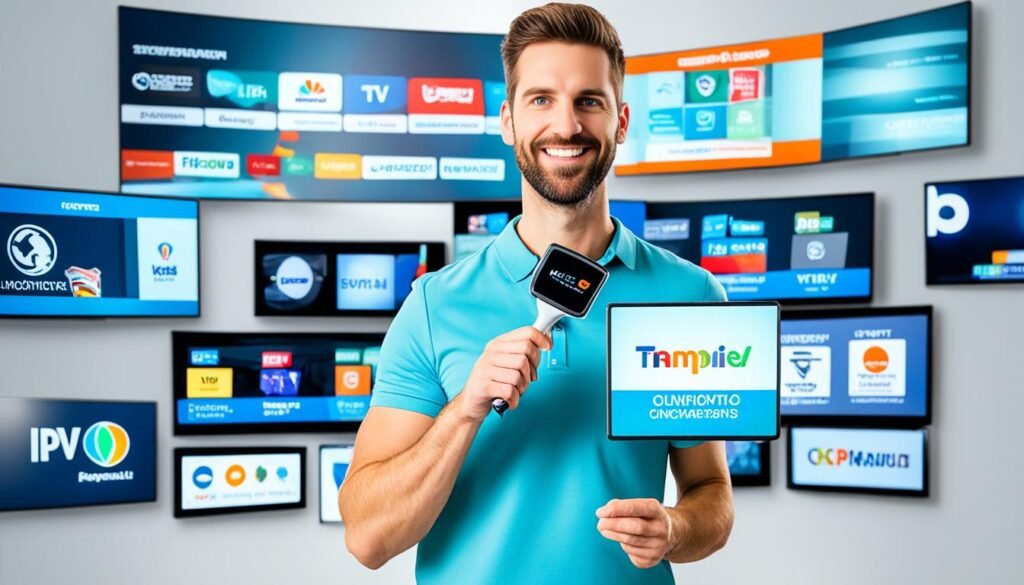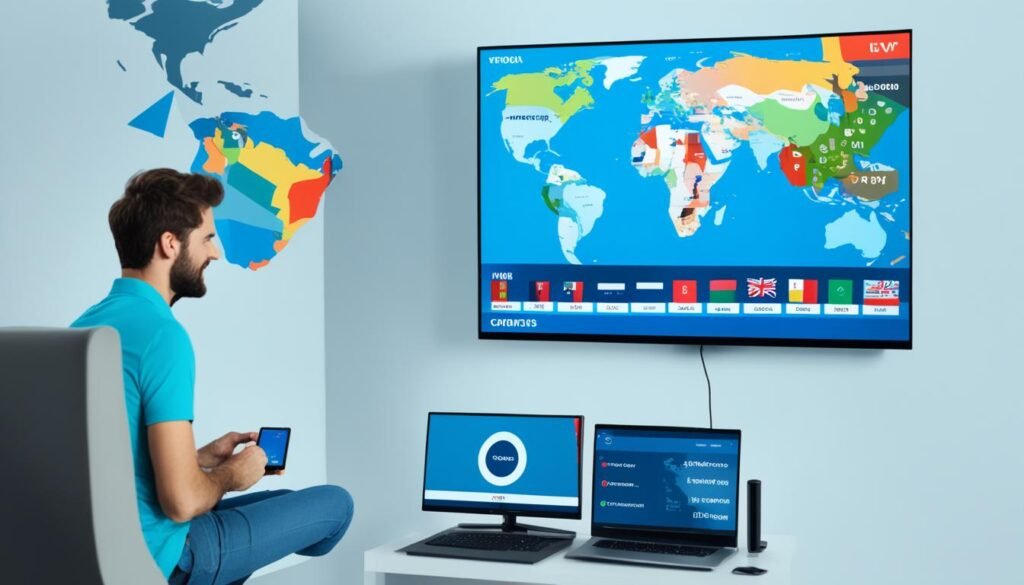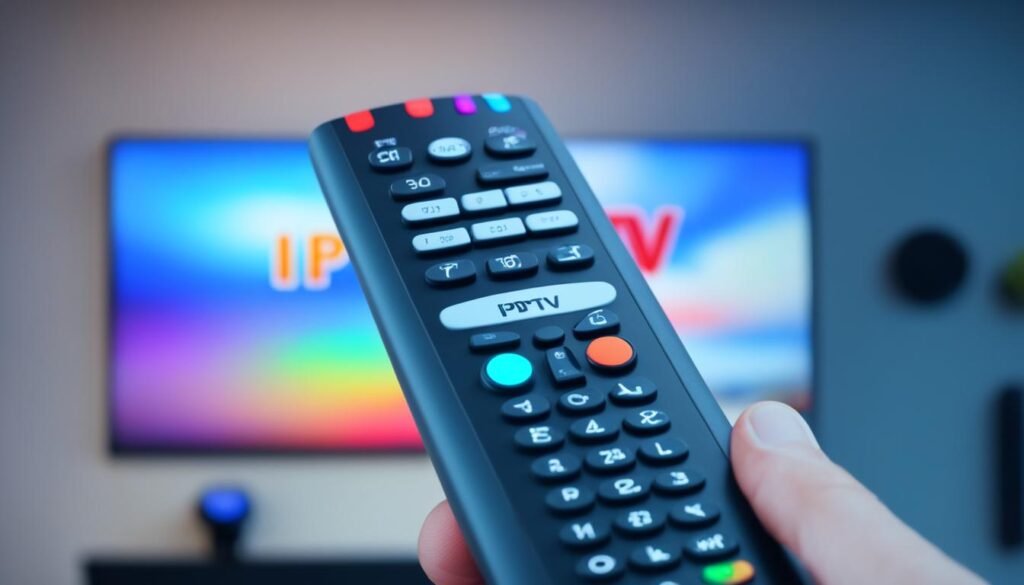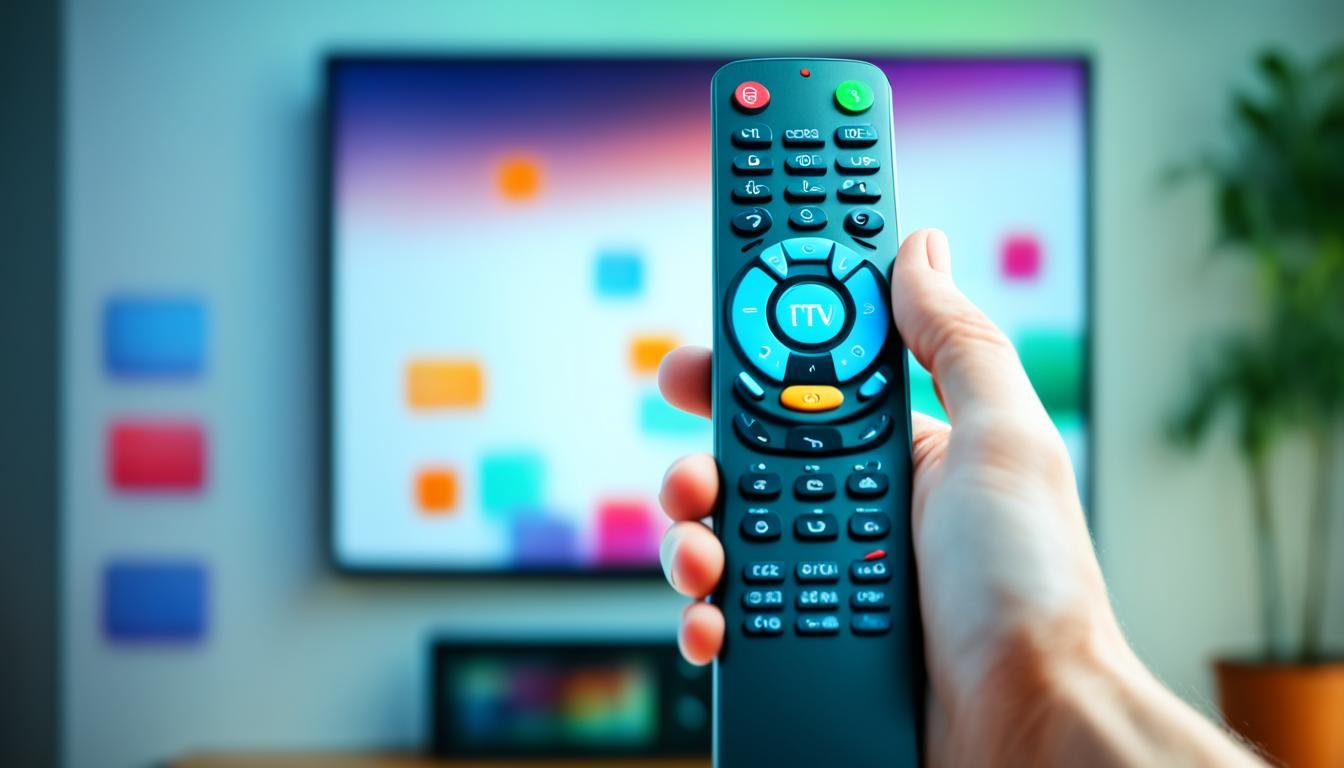More people are choosing IPTV as a new way to watch TV instead of cable or satellite. It’s cheaper and lets you watch what you want, when you want. In this IPTV tutorial, we’ll show you how to set it up, from start to finish. It’s easy to follow, whether you love tech or just want to watch your favorite shows.
Key Takeaways
- IPTV is gaining popularity as a cost-effective alternative to traditional TV services.
- Setting IPTV allows for flexibility in viewing preferences and schedules.
- The guide will cover everything from installation to troubleshooting.
- Understanding IPTV technology is key to enhancing your viewing experience.
- Stream your favorite shows anytime and anywhere with IPTV.
What is IPTV and How Does it Work?
IPTV, or Internet Protocol Television, is a new way to watch TV. It uses IPTV technology to stream shows and movies over the internet. This means you don’t need antennas, cable, or satellite to watch TV. Instead, you use your internet connection.
This method gives you a more interactive and personalized way to watch TV. You can watch a huge library of content whenever you want. It’s all thanks to the power of broadband connections.
Understanding IPTV Technology
IPTV works by sending TV signals over the internet using internet protocols. It doesn’t need cables or broadcasting towers like old TV methods. Instead, it uses the internet to deliver TV signals, making it more flexible and high-quality.
Users get to enjoy high-definition content on their devices. IPTV technology keeps getting better, offering features like watching shows whenever you want. This is a big change from traditional TV, which only shows shows at certain times.
Differences Between IPTV and Traditional TV
When you look at IPTV and traditional TV, you’ll see some big differences:
| Feature | IPTV | Traditional TV |
|---|---|---|
| Delivery Method | Internet Streaming | Broadcasting via Satellites/Cable |
| Content Availability | On-Demand and Live | Primarily Live |
| Interactivity | High (Pause, Rewind, etc.) | Limited |
| Device Support | Multiple Devices (Smart TVs, Phones, Tablets) | TV Only |
This table shows how IPTV gives you more options. It’s a great choice for people who want to watch TV their way, whenever they want.
Benefits of Setting Up IPTV
Setting up IPTV offers many advantages for today’s viewers and those watching their budgets. It makes watching TV better than traditional cable services in many ways.
Cost-Effectiveness of IPTV Solutions
IPTV is known for being affordable. It’s cheaper than cable or satellite TV, with lower subscription fees and no hidden costs. With cost-effective IPTV solutions, users can pick from pay-as-you-go plans and flexible packages. This lets them choose channels they like best.
Convenience of Streaming Anytime, Anywhere
The convenience of streaming is a big plus of IPTV. You can watch your favorite shows and movies on devices like smartphones, tablets, laptops, and smart TVs. This means you can watch from anywhere, making it easy to enjoy entertainment anytime.
Essential Equipment for IPTV Installation
Setting up IPTV needs specific gear for a smooth watch. Knowing what equipment and devices work best is crucial. Also, having the right internet is key for no interruptions.
Supported Devices for IPTV Streaming
Many devices can make watching IPTV better. Think about using:
- Smart TVs from brands like Samsung and LG
- Streaming boxes such as Roku, Amazon Fire Stick, and Apple TV
- Tablets and smartphones running Android or iOS
- Gaming consoles like Xbox and PlayStation
These devices make it easy to connect your IPTV service. This lets you watch your favorite shows in many ways.
Internet Requirements for Smooth Streaming
A strong internet connection is a must for IPTV. You’ll need:
- A minimum download speed of 10 Mbps for standard definition
- At least 25 Mbps for high definition
- Stable connection with low latency to prevent buffering
Checking your internet speed before setting up is a good idea. If your speed meets these needs, you’ll get the best from your IPTV service.
Choosing the Right IPTV Service Provider
In today’s digital world, picking the right IPTV service is key for a great streaming experience. You need to think about content variety, subscription costs, customer support, and user reviews. Doing your homework helps make sure the service fits your viewing habits and likes. Here are some important things to consider and a list of top choices in the UK.
Factors to Consider When Selecting a Provider
- Content Variety: Choose providers with lots of channels and on-demand content.
- Subscription Costs: Check out different prices and any extra fees.
- Customer Support: Good support can make streaming smoother, especially when you have tech problems.
- User Reviews: Hearing from other users can tell you about the service’s trustworthiness and quality.
Top IPTV Service Providers in the UK
| Provider | Content Variety | Subscription Cost | Customer Support |
|---|---|---|---|
| BT TV | Comprehensive English & International Channels | From £10/month | 24/7 Support |
| Sky Q | Large Selection of Channels & On-Demand | From £25/month | Online Chat & Helpline |
| Virgin Media | Extensive Movie Collections & Sports | From £34/month | 24/7 Support Available |
| NOW TV | Flexible Passes for Movies & Sports | From £9.99/month | Email & Live Chat |

Preparing for Your IPTV Setup
Getting ready for your IPTV setup is key for a smooth streaming experience. Make sure your internet connection is strong enough for the service. Also, having all the info you need for IPTV makes the setup easier.
Check Your Internet Connection
Checking your internet speed is crucial before setting up IPTV. IPTV needs a certain speed to work well. You usually need at least 10 Mbps for standard definition. High definition might need 25 Mbps or more.
To check your internet for IPTV, follow these steps:
- Use a trusted speed test website to measure your current internet speed.
- Compare the results with the requirements needed for your IPTV service.
- Consider upgrading your internet plan if your speeds are below recommended levels.
Gathering Necessary Information from Your Provider
Having the right info for IPTV makes setup easier. Make sure you have these details from your IPTV provider:
- Account Credentials: Username and password for your IPTV account.
- Server Information: The URL or IP address of the IPTV server you will connect to.
- Configuration Settings: Specific settings required to set up your streaming device.
Step-by-Step Guide to Setting IPTV
Setting up IPTV might seem hard at first, but it’s easier with a clear step-by-step IPTV setup. This guide will help you with the installation and configuration on different devices.
Installation Process Overview
Start by making sure all your gear is ready. Here are the steps for a smooth setup:
- Unpack your IPTV device and connect it to your TV with the right HDMI or AV cables.
- Plug the device into a power outlet and turn on your TV.
- Pick the correct input on your TV to see the IPTV device’s interface.
- Use the on-screen directions to connect to your home Wi-Fi. Make sure to enter your wireless password correctly.
Once you’re connected to the internet, you can access the IPTV service provider’s interface.
Configuring IPTV on Your Device
After setting up, it’s time to configure IPTV. Here’s what to do:
- Open the IPTV app on your device.
- Enter the activation code given by your IPTV service provider if needed.
- Choose the channels or packages you want based on your subscription.
- Change settings like video quality and streaming preferences to fit your viewing habits.

After setting everything up, you can enjoy streaming with your IPTV. Each device might need different steps, but this IPTV installation guide covers the main steps for any setup.
Setting IPTV: Common Troubleshooting Tips
IPTV users often face issues while watching their favorite shows and movies. Knowing how to fix these problems can make your viewing better and reduce frustration. Here are some tips to help you troubleshoot IPTV issues.
Fixing Buffering Issues
Buffering is a common problem with IPTV. It can make watching shows and movies frustrating. Here are steps to fix buffering:
- Check your internet speed. Make sure it’s at least 10 Mbps for HD streaming.
- Restart your router to refresh the connection.
- Limit the number of devices on the internet to avoid slowing down your speed.
- Try using a wired connection for a more stable performance.
Resolving Login and Authentication Problems
Having trouble logging in can block your access to IPTV. If this happens, try these steps:
- Double-check your login details for any mistakes.
- Clear the app cache or reinstall the IPTV app to fix glitches.
- Contact your IPTV provider to check if your account is active and okay.
| Issue | Common Causes | Suggested Solutions |
|---|---|---|
| Buffering | Slow internet, many devices connected | Check internet speed, restart router, use a wired connection |
| Login Problems | Wrong credentials, app bugs | Verify credentials, clear app cache or reinstall |
By using these IPTV troubleshooting tips, you can solve common IPTV problems. A smoother viewing experience is waiting for you with the right steps to fix these issues!
Customizing IPTV Settings for Enhanced Viewing
Making your IPTV experience better can really boost your fun. You can change settings to fit what you like, especially with video quality and EPG features. This makes watching shows smoother and more enjoyable.
Adjusting Video Quality and Streaming Preferences
First, tweak your customizing IPTV settings by adjusting video quality. Most IPTV services let you pick settings based on your internet speed and device. You can change things like:
- Resolution settings ranging from standard definition to high definition
- Adaptive bitrate streaming for optimized quality based on real-time bandwidth
- Aspect ratio adjustments to ensure a perfect fit on your screen
These changes can make streaming much better. If you pick settings that match your network, you’ll see less buffering and have more fun. For more tips on customizing, check out this link.
Utilizing EPG (Electronic Program Guide) Features
EPG features change how you watch shows. With EPG, you can:
- Effortlessly navigate through an array of channels
- Schedule recordings in advance
- Set reminders for favorite shows and movies
These tools make watching shows easier. You get a clear view of what’s on, so you won’t miss anything. Changing these EPG settings helps you manage your TV time better. Looking into more features can make your IPTV even better.

Staying Updated: Legal Considerations for IPTV Usage
It’s vital to know the legal side of IPTV services in the UK. There are many important legal points users need to understand. These include issues with licensing and following UK broadcasting rules.
Understanding Licensing and Copyright Issues
Licenses are key to making sure IPTV services are legal. Providers must get the rights to show TV shows, movies, and live events. If they don’t, they and their users could face big legal problems.
So, it’s important for users to check if their IPTV service has the right licenses. This helps avoid legal trouble.
Staying Compliant with UK Broadcasting Regulations
The UK has strict rules for broadcasting to protect viewers and keep content honest. IPTV users must know these rules to avoid breaking them. Providers must follow rules about what they show, how they advertise, and how they treat customers.
Being careful with these rules makes watching TV better and keeps users safe from legal issues.
Conclusion
IPTV offers more than traditional cable TV. It brings flexibility and convenience to viewers. You can watch a wide range of content on various devices at your own time. This makes it perfect for today’s viewers who want to watch shows anywhere with a good internet connection.
This article has given a detailed guide on setting up IPTV. It covered what you need, how to install it, and how to customize it. By following these steps, users can greatly improve their viewing experience and save money with IPTV plans.
When thinking about IPTV, it’s key to pick the right provider for you. With the right service, IPTV can change how you watch entertainment. So, why not start streaming your favorite shows and movies now?

